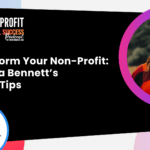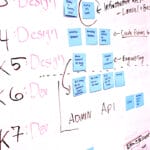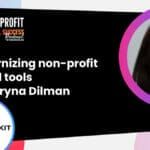Video recording
Audio recording
In this episode, we’re glad to have Carol Hamilton on the show! She’s the Principal at Grace Social Sector Consulting and also a fellow podcast host for the Mission: Impact Podcast.
She’s a strategic thinker and works with organizations to envision their future strategy. Practical in her approach, she helps organizations think through who is key to creating their future, how to gather insights, imagine new possibilities, come to agreement on future goals and create an action plan.
With more than 25 years of nonprofit experience, Carol trains frequently on leadership, strategy and innovation topics. She graduated from Swarthmore College and has her Masters in Organization Development from American University.
We brought her on the show to hear her insights about strategic planning and how non-profits can make the most of it to reach their goals.
Episode Transcription
David: Welcome to the Non-profit Digital Success Podcast. I’m your host David. Today, I have Carol Hamilton on the show, allow me to introduce her. Carol is a principal at Grace Social Sector Consulting, located in the DC area. She’s a strategic thinker and Carol works with organizations to envision their future strategy. How amazing is that? She’s practical in her approach, she helps organizations think through who is key in creating their future, how to gather insights, imagine new possibilities, come to an agreement on future goals, and create an action plan.
With more than 25 years of non-profit experience, Carol trains on leadership strategy and innovation topics, and she has her master’s degree in organization development. Carol is also a fellow podcast host. Carol, tell us about your show and what it’s called.
Carol: Oh, thank you first for having me on the show, it’s great to be here. My podcast is called Mission Impact, it’s the podcast for non-profit leaders who want to do good in the world without being a martyr to the cause.
David: That’s amazing. So if you’re listening to this, listen to the whole episode and then you can go and find Carol’s podcast afterwards and subscribe. There’s some really, really great topics that she covers in there. So formal welcome, thank you so much Carol, for jumping on the Non-Profit Digital Success Podcast. Great to have you here. So I’ve got, you know, really high-level question for you. I’ll just lob that softball at you, what is strategic planning?
Carol: It really is a process to help organizations, and really the people within organizations, because that’s what organizations are. They’re networks of people come together and have conversations so that they’re all clear on where they’re headed, where they want to go, and how they’re going to get there.
For me, I think the value that it brings is that chance to kind of step back, and think about the bigger picture, and think about the longer term. But usually, they focus on kind of the next three to five years for most organizations, that’s a reasonable amount of time to kind of think ahead.
David: Yeah. So it’s not immediate, it’s not like the next 90 days or one year. It’s kind of like, I would call that maybe mid-range kind of forecasting in strategy for three to five years.
Carol: Yeah, and I mean, people have kind of questioned whether strategic planning is even relevant anymore with our world being, you know, that acronym, the “VUCA”: Volatile, Uncertain, Chaotic, and Ambiguous. That’s what we swim in these days, and certainly, the last several years have, if folks weren’t convinced of that before they certainly should be now.
But at the same time, I would say, don’t, you know, don’t just throw it all out. You can still decide where you want to go and make sure that everyone’s in alignment and that you’re moving forward in a direction that you’ve all agreed on
David: As a business owner, like I have an agency, right? It’s really important to have a strategy. You need to know where your compass is pointed so that you and your team and your organization as a whole can travel in that direction, and everybody is kind of, you know, paddling in the same direction to help you get to where you want to be. It’s a really important piece for people to understand that, you know, you need to have your core set of values and understanding about what your organization does, but you need to know what the ultimate plan is in three or five years.
If the plan is to raise a million dollars so you can set up a new business or a new wing of your facility, or, you know, tackle a certain thing, you need to have that and you need to create all the different pieces to help you get there, right? It’s not like, “oh, I wanna do this, and it’s just done”. It takes time.
Carol: Right. It takes time, and it takes thinking through kind of “how are we gonna do that? What are the obstacles we need to face?” and just making sure that you’re actually in alignment. And I think that’s one thing that leaders can often, maybe, be a little concerned about when they launch into a strategic planning process.
That they’ve got so many stakeholders and you know, all of the staff, the board and is every, you know, folks have all sorts of ideas about what they should do, what they could do. So there is a fear that people have kind of coming into strategic planning is around, you know, how are we gonna align all of that? How are we gonna take all that input and kind of make some decisions about what’s important? But what’s been interesting for me in working with organizations is that once we get into it and we start having those conversations.
What I find is that actually there’s more alignment already there than people realize. And so kind of framing up those conversations gives people the opportunity to see that and kind of have that sigh of relief. I’ve often had that with, with clients where, you know, the takeaway from the session is, “Oh, I feel so much better because now I realize, you know, folks are feeling the same way as me”, or, you know, “they have the same aspirations, they have the same concerns”, you know, kind of that validation of being more in alignment than they realize,
David: Right. It means that organizationally you’ve got the right values and the right people in the team that are helping you get to where you wanna be, and everybody’s like buying into what the organization wants to do and achieve. And I think that that’s a really important thing, you know, going through strategic planning. What are some of the common mistakes that organizations tend to make when they’re engaging in that process?
Carol: Yeah, I think, so out of that fear of how can we assimilate all this information and input from so many different stakeholders and what kind of expectations will we raise if we involve them? I think sometimes leaders will try to kind of tamp down the process and make it feel more manageable.
So they have less people involved, which is efficient, you know, again feels manageable, but what it can do is you then, you know, like they go forth with the plan. They come up with a plan and then they tell everyone else and then wonder why everyone else isn’t as excited about it as they are.
Really being more open at the front end of being willing to hear and engage with a variety of different stakeholders, internal and external, but then also being clear with those stakeholders, how are you using that information? It’s not that we’re gonna just come up with this laundry list of everything that everyone wants and not have to make some decisions. How is that information gonna be distilled? And then who’s gonna be using it, and then who’s ultimately gonna be making some decisions around the goals.
David: I’m gonna say something that I love to say, I say it all the time, you need to get the inside, on-side. It’s really about, you know, getting the engagement from the staff, the volunteers, if you’re dealing with families of clients or this or that like you need to really engage on multiple different levels.
I think some people are maybe afraid of what that actually means and maybe the amount of work and time and effort that’s needed from their side. Do you find that that’s kind of what happens?
Carol: Well, when groups bring a consultant in, oftentimes a consultant will be able to take on a lot of that information gathering of doing those interviews. You know, managing focus groups, synthesizing all that information for the board and staff to then be able to work through and make meaning of, and to then be able to make decisions.
I think another thing about starting to sprawl, there also has been this traditional notion that there’s a real kind of bright line between what does staff do and what does the board do? And the board being the only ones who are kind of tasked with strategy.
I would really challenge that, not to say that you wanna have your board kind of getting into the staff lane of like worrying about operations or, you know, getting into the nitty gritty of who’s sitting at what table and what fundraising event. You wanna keep a board out of operations and kind of thinking higher level.
But I feel like there really needs to be a conversation with board and staff because ultimately it’s that entire group that’s going to make, and volunteers, that’s the group that’s gonna make all of this happen. And so each brings its own perspectives, its own experience.
I’m not really a believer in, you know, that there’s kind of this sense of “if you’re higher up in the organization, you’re the ones doing strategic thinking. And if you’re further down, closer to the front line, you’re not”. I just don’t necessarily believe in that dichotomy, I think everyone’s capable of strategic thinking. It’s just kind of, how do you frame the conversation? How do you bring people in? And sometimes it makes folks uncomfortable whether they’re board or staff. If they just are more kind of operationally oriented.
Asking them to think big picture, think about longer-term trends, you know, visioning can be uncomfortable, but it all helps to move, you know, make that final product a more meaningful.
David: Yeah. I think it’s really important to empower your staff to one, maybe make their job more efficient. Maybe there’s something that they can do, not even talking about, like the strap planning side of things. Right? But you’ve hired them for a reason, for the role that they have, because they’re experts or they’re really fantastic at job X, Y, or Z. They can get it done, and really help your organization in that way. But empowering them and bring them into conversations, brainstorming sessions, round table conversations, things like that.
I think there’s lots of ways that organizations can definitely engage with the staff¿. I’ve worked in non-profits for 16 years, and what I found is once staff are engaged, it actually tends to tick upwards in terms of like staff happiness and KPIs and their impression of the organization.
So there’s more to this than just “okay, we need to strap plan.” There’s a lot of other ways that it kind of filters down.
Carol: Yeah. I think there are a lot of kind of ripple effect benefits of really being mindful of how you’re engaging people. And I think it also just, you know, people are like, “why would we do that? We’ve got so much on our plate”. It just gives everyone an opportunity to kind of like lift their eyes up a little bit from today’s to-do list or, you know, what’s worrying you about all the meetings you’ve gotta get prepped for next week.
But, like what’s a little further down the line? What’s a little bit bigger? Why are we really all here doing all of this? It helps people reconnect to that as well.
David: Absolutely. This is a great, you know, segue into my next question. Who needs to be involved or who should be involved in strap planning?
Carol: Yeah. So that’s often a conversation that I’ll have at the very beginning, whether it’s with a core team of staff or usually often a strategic planning committee that includes both board members and staff members. We go through a process to really brainstorm who are the organization’s stakeholders, what is the ecosystem that they’re, you know, working within and also to think about kind of where are they in terms of their organizational life cycle?
Because that process of gathering information from people can really work at a number of different levels. It could be if an organization has never done this kind of process before, it could be just, you know, that needs to be a basic organizational assessment of where are they?. What are their strengths? What are their challenges? What are their aspirations? Or it could be at a higher level of, you know, thinking what are the big strategic questions that we’re thinking about because they already have some really good processes in terms of gathering information.
But I have a feeling I lost track of the question, which I think was who, right? So we’ve talked about that.
David: Is there anybody, is there like a job title? That’s like, “alright, these are the four people that always need to be there” or is it, does it change based on the organization?
Carol: Yeah, no, that’s a great question. I think, well, we’ve named two. I think board and staff definitely need to be involved in some way. And then the external stakeholders are gonna really depend on what is the purpose of the organization. You know, what kind of work are they doing and who do they do it with? So who are their partners? Who are their funders? Are they heavily involved in the political process? Is that, are those key constituents for them?
You mentioned the folks that the organization supports or serves, how are you involving them in the decision-making? And there’s more and more emphasis on, you know, the folks who are really living, whatever the issue is that the organization is working on really need to be integral into making decisions.
So how are you involving them as well? So it can be kind of more from the internal side, who are your key volunteers. It’s just looking at the organization, what’s the work that you’re doing, and then who matters to that work. But I think, you know, at basis, pretty much staff and board are always gonna be involved in some way in your key volunteers.
David: I have a couple of follow-up questions from that. Is there an easier way or a specific method that you could recommend to help get external stakeholders involved in the process and like be willing to join and take time out of their lives?
Carol: Yeah, mostly with external stakeholders, depending on what the relationship is. It’s often the case where it’s asking them to do a half-hour interview with either a member of the strategic planning committee or with the consultant to just get their perspective, get their, you know, some perspective on the organization.
It may be that they actually don’t really know much about the organization, but they’re very knowledgeable about the field. And so then you’d be asking them about trends and things like that. So it’s not that they’re gonna be there at the retreat or in the series of, you know, online sessions that are about deciding the future of the organization, but it’s more like, you know, having a conversation, maybe inviting them to a focus group, that kind of thing.
David: It’s really fascinating. One of the things that we do is we have like our discovery process that we go through and we talk about like personas and we build out some at avatars and things like that. Is that something that you might do or consider doing as part of the strategic planning, like in order to help inform what that end result is?
Carol: Yeah. That’s a really interesting way of thinking about it. I think probably if an organization has, you know, also one of the things that I always wanna find out when I’m working with them is what other discovery processes have been gone through recently, you know, have they done a survey of their members?
Have they, you know, recently just finished a project like you might do with a website where they’ve done all that analysis and they have those avatars of, you know, typical folks who are coming to their website and things like that. And to then to build on that, right? To not assume that they’re just a blind slate, but know that they’ve been doing a lot of work.
And so how do we do that kind of next step? So you could say that those stakeholder groups might kind of fit into those avatars, but they’re probably more on the traditional side of what are the groupings of folks that they can think of, you know, within their ecosystem that are key to their future.
David: I always think it’s important as an organization to think about things through the lens of the people that either use or buy your products or come and participate or volunteer or donate, right? And being able to think of it through their eyes.
Kind of break down those silos that tend to happen at organizations that are a little bit bigger and think about things through their eyes, really clarifies and cleans up any misconceptions that might be out there.
Carol: Yeah. So that could be a really useful process to kind of help the group once you’ve gathered information from all those different groups think about. So, you know, we tend to think about them in these buckets, but what’s showing up in between those, in terms of these different personas of the folks that we serve, the folks that we, you know, are working with to move our mission forward.
David: How would you approach, I guess, starting strategic planning or that initial process that needs to happen when you’re about to embark on strategic planning? How do you do that with non-profits and NGOs?
Carol: Yeah. So, I mean, oftentimes there’s a fair amount of a process before I, you know, they pick up the phone and start calling, “who do you recommend? who helps organizations do this kind of thing?” So, you know, it’s important to know, is this just one person who thinks this is important to do? Is there kind of a critical mass among the leadership of the organization that really wants to invest the time and energy because you know, it is an investment.
I do try to, when I’m approaching, I say, “you know, I want to make strategic planning, fun. I don’t want it to be this onerous process”. I’ve heard people describe other strategic planning processes that they’ve gone through as like, well, I don’t wanna, you know, endure that soul-sucking experience again.
So really trying to, you know, make it not heavy, and kind of keep the momentum going. But in terms of getting started, it’s often like having a conversation of, you know, starting to think, are we all on the same, you know, playing field? in terms of where we want to go and talking with board and your board about the need for it.
There’s some times when you don’t wanna do it, if the organization is in a major crisis, it’s not a time to try to think three to five years in advance. You’re dealing with the next week, the next month, you know, the next six months. So I’ve worked with groups that, where they came saying that they wanted strategic planning, but once we got a little bit further into it, it became really clear that they were in a crisis, or they were kind of emerging from a crisis, and so as much as they could plan out was gonna be 6 to 12 months.
And so that’s what we did, but in terms of once they pick up the phone and start talking to if they decide to have external support, and of course, I’m biased in that arena, but I do think it brings value to have somebody who’s managing the process who has no vested interest in the outcome.
It also enables folks who are in those leadership positions, whether it’s the board chair or the executive director to really be a participant in the process and not have to be thinking about managing the process. And, you know, a lot of groups will then decide they have to do an RFP. I’d say, “please, don’t please just have conversations with people and see if there’s a fit. And then if you need a proposal, you know, go from there.”
David: Yeah. I really like what you said in there about, okay, fine. You’re biased. Totally get that. I think everybody listening will, will understand and appreciate that, but really, you know, hiring an outside body to come in. It brings in a certain level of expertise because you’re bringing in like the person that has done this over and over and over again, and has seen the trends.
It can really help you quickly get through the process and as painlessly as possible, instead of trying to cobble it together or try to have somebody that, you know, maybe they went through a strategic planning of an organization they were at previously, but they’re not really the experts.
There is something to be said for bringing in somebody who can bring the best practices from multiple organizations that they’ve done this with before.
Carol: Yeah. And I think the other thing that can be valuable is when something emerges in all of the discovery, in the, you know, interviews and the focus groups and the surveys, you know, I’ve worked with various organizations where they’re in a, in that one of those transitional stages between kind of, you know, levels of maturity of the organization development. And so I can help them kind of normalize the fact that, okay, say you’re going from a founder to the next generation.
You know, here are the common things that are going to be happening, here are the common challenges. And, and it also goes back to that kind of like, “oh, we’re not alone. This isn’t something uniquely bad about us, that we’re doing something wrong”.
It’s just the typical growing pains that an organization has when it’s going from, you know, phase two to phase three or whatever it might be. So those are also kinds of things that I can bring in or any consultant can kind of help bring some context, some broader context to an organization that will help just bring a different perspective to their particular situation.
David: I’ve gone through strap planning a couple of times with the organizations that I worked at, and there was always a little bit of a contentious debate onsite or offsite. What’s your take?
Carol: Well, now it’s not even it’s, you know, onsite, offsite or, online. And, you know, the last several years, of course, we’ve been doing all of it online and I’ve actually found that there’s quite a bit of value in that, you know, that the kind of traditional model used to be, you bring everybody together.
You know, I would say ideally in an offsite, because that gets people away from their day-to-day to help them think bigger. But of course, you know, online, you’re not necessarily getting away from your day-to-day, your email and whatnot may be there. So I always invite people outside, like ” okay, can we close those off? At least for these two hours that we’re working on this piece”, but the value in kind of splitting it up and not having it be a one-day marathon where, you know, you get to the point in the day when everyone’s just wiped.
That’s when you have to actually make some decisions when nobody’s brain is working, splitting it up into smaller segments and doing it over, you know, a couple weeks can actually have some value because people: 1. just taking one bite at a time and then people also have time to kind of think and process and internalize this last conversation to be ready for the next one. So I would say either offsite or online.
David: Fair enough, so option C, online. So, non-profits, we know there can be challenges, right? You were talking to a little bit about RFP process, right? And see, you know, having those kind of conversations aside from, you know, RFP, not RFP, quote, that type of thing. What else do you find makes strap planning maybe a little bit more challenging in the non-profit space?
Carol: I mean, I just think the folks are overwhelmed. We’ve definitely been, I mean, it was before the pandemic that folks were talking about burnout and just how much people are working and, and how stretched folks are in terms of the needs that they’re trying to address, the issues that they’re trying to address, and then of course, it’s just even more so now.
So I think there’s just the press of the data, you know, of the current challenge. And so it can feel, yeah, almost luxurious to take that step back and, you know, pick your eye off of today’s to-do list, and look a little bit longer. But at the same time, I would say it’s really an investment in the organization to bring people together and have those conversations.
David: Right. If there’s any kind of question that somebody should be thinking about before they come into that first interview or that first stakeholder engagement meeting that you might hold, are there any questions they should be thinking about to help get their mind into that strategic thinking mode?
Carol: Yeah, that’s a great question. I mean, oftentimes I’ll work with the strategic planning committee to identify what those questions are. What, you know, what level are we working? What are the big strategic issues that the organization needs to grapple with? And so those will then be integrated into that whole process of getting input. And usually where I start with the group where we’re really moving into the planning process is to start with that, with the feedback of what I’ve heard from this wider range of stakeholders.
That grounds them in, how do people see the organization now? What are the challenges that they see? What are the strengths that they see? And then we often end up with that kind of laundry list. I kind of call it well, “here’s your buffet of all the different things people are talking about, about what you might be able to do, what you, what they think might be useful to work on in the future.”
And that almost becomes kind of food for thought. I was on another conversation, I was like, well, that’s the compost that you start with before the gardening process. And then I’ll often have to get people kind of out of that day-to-day is to actually start not just thinking about the organization, but thinking about the wider environment.
What are the trends that they’re noticing in a variety of, you know, within politics environment, social technology. And then, of those trends, what are the ones that are really impacting their organization, their issue, their mission, and that kind of pushes people into bigger thinking and into wider, kind of widens the lens if you will, that helps them get into that mindset to be able to think longer term.
David: That’s great. Do you have any additional tips or last-minute thoughts that you could recommend to the listeners?
Carol: I would say, you know, definitely if you’ve never done a plan, take the time, invest in it. Even if you can’t afford to have outside help that you’re paying for, you may be able to get that help through, you know, a graduate program locally that, that focuses on non-profit management, a group of students that could help you with some of that research and, and facilitating a conversation.
So there are lots of different ways that folks can tackle it, but also being mindful of like, “is this the right time to do strategic planning?”. Like I said, if they’re in a crisis, you know, maybe six months from now, maybe a year from now, once you’ve emerged from that, if they’re about to go through a leadership transition, oftentimes the outgoing leader will wanna “let’s do the strategic planning now. Now I’ve like, I’ve set the course for the organization for the next three to five years.”
Well, actually I’ll say to them, “that’s the job of the next person”, what we need to do now is do an organizational assessment so that the board’s ready to hire the next person and knows what they need to do. But let that next person come in and really start to define, help, be part of defining what the real long or the midterm future is. And so, yeah, about readiness and then being mindful of whether they have the capacity.
If they’re launching a capital campaign and a doing rebranding and thinking about a website, if they’ve got a bunch of really big other initiatives going on, it’s also not the right time to do strategic planning. There needs to be enough time and bandwidth to really be able to focus on it.
David: And I think that’s really key, right? You need to be able to have what I would call stability and kind of a little bit of a calmish. I know in non-profits, it’s really kind of hard to find that time when, you know, “people are not busy” because we’re busy all the time.
But finding that period where there isn’t really those big things kind of happening to allow yourself the mental capacity to be able to focus and think more strategically.
Carol: And then once you’ve done one, you know, oftentimes it will be, you know, that three year or that five year, and then it can become a regular practice. And depending on where you are after that three years, it may be that you just need to, you know, revisit the plan and refresh it.
It may be that you’ve really made progress and you need to envision for the future. And then I think the other really key thing is that what I always try to have clients make sure that they do is to not worry about trying to, you know, exactly predict what you’re gonna be doing in year three of the plan, but really only focus on getting into the nitty gritty in that year one action plan.
So that you’ve had a conversation about how, you know, how are we putting this into implementation? What are we prioritizing first? And then also setting a date for when you’re gonna review and update the plan either six months or, or a year from now,
David: For sure. I think the action plan is, you know, one of the big takeaways that come out of strategic planning when I do strap planning for my business and in my agency, we do one year, three or five year, but then we also do a quarterly kind of like “let’s check-in.
Here’s where we’re going for the year. Let’s get together. What are the rocks? What are those like three big things that we can really focus on?” And it might be different for different departments and different people in the organization, but really breaking it down so that you’re all working towards these pieces that collectively will get you to where you want to be.
Carol: Yeah. And I think that you made a really good point of like, you know, the three things I don’t let groups have more than five goals and that’s probably too many, but sometimes you end up with seven and it’s like, “Okay, no, we gotta rank these. We gotta prioritize them because that’s too much to try to take on in this period”
David: You have a couple of bonus schools, right?
Carol: Yeah. So?
David: They need to be smart goals, right? and achievable. So that’s, you know, a very key point. So to everybody listening, I know today, this episode was a little bit different than our typical kind of episode, but I think it’s a really important topic. And for your organizations to start thinking about strategy and focus and gaining clarity on where you want to go and how you’re gonna get there, it’s a really important piece for you.
I hope if you’re listening, if you’re still listening that you’ve been able to get some really great advice from Carol and some pointers today, from our conversation Carol, during the pre-show you mentioned a tool maybe for strategic planning that you’ve got. Can you tell us about that?
Carol: Yeah. So we talked about one or two of the mistakes that organizations often make, but I have a downloadable resource on my website: “the common mistakes that organizations make in strategic planning”. So, and then kind of how to mitigate those as well, so that can flesh that out a little bit more so, at www.gracesocialsector.com and there’s a tab called goodies. So just look under there and you’ll find, you’ll find the resource easily downloadable.
David: Amazing. And we’re gonna have a link on our show notes page. So you can go to www.nonprofitigitalsuccess.com, that’ll take you through to our podcast page, find this episode, click on it, and we’ll have links out there for anybody. And if anybody wants to get in touch with you, what do they need to do?
Carol: Yeah. So just check out my website, we have a contact form there, www.gracesocialsector.com. Also, invite folks to check out mission impact and yeah, that that’s how to be in touch.
David: Fantastic. Thanks again so much for joining in Carol. It’s been great having you here on the Non-profit Digital Success podcast until next time, keep on being successful.














0 Comments